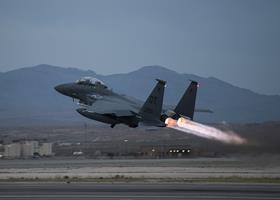The weekend attack against Israel carried out by the Iranian armed forces featured more than 300 missiles and suicide air vehicles – some 150 of which were one-way uncrewed air vehicles (UAVs).
That is the assessment of US defence officials, who provided their summary of the 13 April barrage during remarks at the Pentagon on 15 April.
“99% of those were knocked down,” said Pentagon press secretary Major General Pat Ryder.
Israeli military authorities put the number of weapons fired even higher, estimating some 350 projectiles. The Israeli air force (IAF) says “only a few” missiles penetrated the air defence measures, causing “minor damage” to the country’s Nevatim air base in the Negev Desert.
“The function of Nevatim base was not affected, the planes continued to take off and land and fulfill the defence and attack missions,” the IAF said on 14 April.
The service released gun camera footage showing Israeli pilots intercepting and destroying what it claims are UAVs and cruise missiles launched during the attack. A silhouette visible in one frame resembles that of a Shahed-family UAV.

Tehran says the salvo was launched in response to an Israeli strike against an Iranian diplomatic compound in Damascus, Syria earlier this month.
Among the armaments fired at Israel were ground-launched ballistic missiles, cruise missiles and a large number of one-way UAVs – a weapon system Iran has become infamous for during the ongoing Russia-Ukraine War.
Tehran has been supplying Russia with Shahed-136 suicide UAVs – a low-speed, uncrewed turboprop laden with direct impact explosives.
The historic attack – Iran’s first-ever direct strike against Israeli territory – reportedly saw the deployment of the more advanced Shahed-238, a jet-powered version of the one-way UAV.

While many of the threats were neutralised by Israeli aircraft and ground-based air defences, US forces also assisted in defeating some targets.
“US fighters were involved,” according to Ryder. He declines to provide specific details, including type or number of aircraft involved.
However, Ryder does confirm that land-based fighters were used in the interdiction.
The White House provided an additional hint, releasing a video on 15 April showing President Joe Biden speaking to members of the US Air Force’s 335th Fighter Squadron and 494th Fighter Squadron, with the president commending the aviators for their role in defending against the attack.
Both squadrons operate the Boeing F-15E fourth-generation multi-role fighter.
The 494th is based at RAF Lakenheath in the UK, while the 335th is stationed at Seymour Johnson AFB in North Carolina.
US Central Command (CENTCOM), which oversees military operations in the Middle East, said on 14 April that its forces destroyed at least 80 Iranian attack drones and six ballistic missiles.
“This includes a ballistic missile on its launcher vehicle and seven UAVs destroyed on the ground in Iranian-backed Houthi controlled areas of Yemen prior to their launch,” CENTCOM says.
The defence-in-depth also featured two US Navy guided missile destroyers, according to the Tampa, Florida-based headquarters. CENTCOM commander General Michael Kurilla made an in-person visit to Israel just days before the attack.
Ryder notes that additional military assets had been moved into the Middle East region ahead of the attack, for which Iran claims it provided advanced warning.
Tehran says it communicated to Washington through diplomatic back channels that US forces and facilities would not be targeted.
The Pentagon appeared to take issue with that characterisation, while not outright contradicting Tehran’s claims.
“We were not given specifics by Iran,” Ryder says, specifically noting a lack of exact time or date. “Iran did not tell us when and where they were going to attack,” he adds.
When asked how defending against such a large attack impacted the regional stock of US and Israeli air defence and air-to-air munitions, Ryder declined to answer citing security concerns about “readiness levels”.
Tehran has publicly said it plans no further action against Israel, considering the matter closed. Israel has vowed to retaliate but has not offered specifics.
Senior US leaders, including President Biden, have reportedly told their Israeli counterparts that Washington will not assist in any offensive action.
Story updated 16 April to reflect a Pentagon clarification that only land-based US fighters were used, with other sea-based aircraft in support roles


























